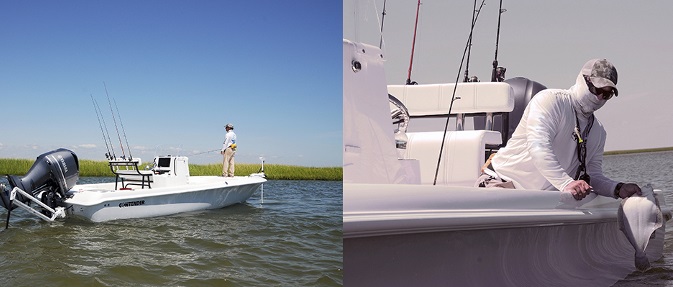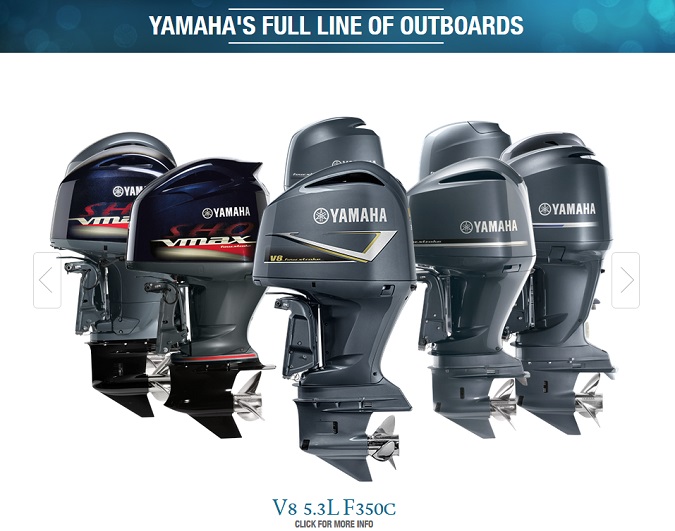In the world of gamefish, flounder probably don’t come to mind. Then again, maybe you’re not that familiar with two of the more popular recreationally caught species that make up the clan. In fact, they are two of the most sought-after gamefish on the East and Gulf Coast. Why? Because they are readily available for a good portion of the year, they are fun to catch and they are good to eat. Now that’s a fishing trifecta!

The summer flounder’s range extends from North Carolina to Massachusetts and for a good portion of the year, they frequent bays and tidal rivers. The southern flounder has a more extensive range. In the Atlantic, the range stretches from North Carolina to northern Florida. In the Gulf, the range stretches from Northern Florida to Texas. They are most frequently caught in bays, tidal rivers, bayous and inlets. The two species look surprisingly similar in shape, coloration and dentation. Both species are aggressive predators, capable of putting up a good fight on appropriately sized tackle.
Both species of flounder share the characteristic flat or laterally compressed form. Both eyes are on the topside of the body, along with a large mouth filled with needle-like teeth for gripping their prey. They lie on the bottom using a chameleon-like ability to alter their top skin color to blend in with their surroundings like a warrior in camouflage. These adaptations make the perfect ambush predator. Regardless of which species is found in your area, they are actively pursued by recreational fishermen and most fun to catch when inhabiting estuaries and near shore structure. The ideal boat to pursue this species is a bay boat equipped with the right accessories to get you into position and help you maintain it.
A few years back we spent a couple days fishing with the captains Vickers, Mike Junior and Senior, both northeast Florida fishing guides, ostensibly for sea trout and redfish. We were working backwater channels and creeks off the Intracoastal Waterway near St. Augustine, Fla., using a powerful electric trolling motor on the bow of their 23-foot Yamaha-powered Pathfinder® bay boat to cruise silently through the narrow passes. We were casting a variety of soft plastic lures on jig heads when a fish smashed one in just a few inches of water, close to a school of finger mullet. It was the most aggressive strike of the day, and the fish immediately ran for the deep water through the middle of the channel taking line off the light-spinning reel with ease. We all thought it was a nice redfish but as it came to the net, it turned out to be a 7-pound southern flounder. What a surprise! It wasn’t the last one we caught during our outings.
On a more recent day of fishing, we joined Ken Pontari of Valhalla Yacht Sales, a Contender®/Yamaha dealer in New Gretna, N.J. We went to fish for summer flounder, also called fluke in some of the Mid-Atlantic States. Ken has been chasing them in the backwaters for years, and has more than a few flounder tournament wins under his belt to prove his prowess. We launched his 25-foot Contender® bay boat at a public ramp in Brigantine, a shore town on a barrier island just north of Atlantic City. The bays, channels and creeks sheltered from the ocean by the barrier islands extend along a good portion of the State’s coastline. There was a striking resemblance to the places we fished with the Vickers and other Yamaha backwater pros in the Gulf States. The scenery is beautiful, tranquil and teeming with bird life. It’s home to a vibrant population of summer flounder from spring through mid-summer. Ken promised to show us his techniques he uses to target the flounder, as well as how his bay boat and its specialized equipment play into his success.
The 25-foot Contender® is a hybrid bay boat with a step-hull, modified Vee-bottom that makes it ideal for fishing skinny water as well as open ocean. Powered by a Yamaha F300 outboard, it’s capable of incredibly quick holeshots in mere inches of water and top speeds in the 50-60 MPH range. The shallow water capability is aided by the hydraulic jack plate, which is located between the engine and transom. It can lift the big outboard high, reducing the depth of water needed to get the boat on plane. During the day, we ran through passes and over shallow bars (that would have left most boats hard aground) to get to some of Ken’s secret flounder holes. When the bigger flounder finally exit the bay in the late summer and fall, Ken runs the Contender® offshore to an artificial reef to fish for flounder. He uses some of his shallow water tricks there, too.

Ken’s boat is equipped with a 36-volt electric trolling motor on the bow and a Power Pole® shallow water anchor system on the transom. Both units are controlled via wireless remotes that Ken wears on a lanyard around his neck while fishing. He can put the boat into position to present lures from the bow-casting platform using the trolling motor, then press a button on the remote to deploy the Power Pole® to remain stationary. He can be jigging from the aft casting platform and use the other remote to control the speed and direction of the trolling motor without having to run back to the bow or stop fishing. These tools make any back-bay fishing experience more productive whether it’s for flounder, redfish, sea trout, weakfish or striped bass.
We left the dock cruising down a well-marked channel at a brisk 45 MPH, and Ken turned the boat hard into a narrow reed-lined channel passing over a shallow bar without slowing down. We were able to fly over grass beds, sand and mud flats to reach a spot where two creek channels met away from boat traffic. There, the current has scoured out a deep trench about 200 feet long and 12 feet deep. This is an ideal ambush point for flounder waiting for baitfish pouring out of the channels on the outgoing tide. The current was running pretty hard, and there was a strong breeze that would have made it nearly impossible to drift the length of the hole effectively. Ken dropped the trolling motor and used it to keep the boat in the exact position he desired.
The fishing technique we used in this condition was jigging beneath the drifting boat, Ken broke out two light action graphite spinning rods filled with 10-test braid tipped with long fluorocarbon leaders. They were rigged with two jigs, one above the other in a high/low fashion, each fitted with a Berkley® Gulp!® scented soft body. He likes both shrimp and baitfish-shaped bodies, and will vary them depending on where he is fishing or general conditions. The bottom jig was about 2 ounces and the top about a half-ounce. Using the trolling motor remote control, he adjusted the boat whenever the wind or current caused it to stray from his desired drift path. We dropped the high/low rigs straight down and began to work them with a rhythmic action. Ken snaps the soft rod tip up and down rapidly, which doesn’t move the heavy bottom jig, but causes the lighter top jig to jerk around imitating a live shrimp. It’s a technique that he has been using to fill the freezer and also place high in a variety of local flounder tournaments. It didn’t take long to produce a nice fat fluke. A few fish later, Ken picked up the trolling motor, he hit the throttle on the big Yamaha and whisked us away to another spot. He took us to the back of Abescon Inlet where the tide was about an hour away from incoming high. He set up a drift, again using the trolling motor to be sure we floated over some very subtle structure spots where he often finds bigger fluke. The water was deeper so we had switched to a heavier bottom jig, but he used the same jigs and technique.
“Flounder move into the estuaries from offshore in early spring, well before the season opens,” Ken said. “Some of the first places I fish are way back in the bay and very shallow where the water warm earliest. I like places where a creek enters a channel or pond-like area and flounder wait in ambush for baitfish coming out of the grass beds, with the falling tide. I fish with a single light jig with Gulp!®, and I use the Power Pole® to hold the boat in position to cast to likely ambush points. A little later in the season the flounder will spread out around the bay, gathering in spots where there are deeper holes, channel bends or structure in and around inlets. The larger flounder will begin moving out of the estuaries in midsummer, and fishing along the beaches and further offshore around structure like artificial reefs will produce a lot of nice fish.
“The Contender® is the ideal boat to catch them on the reefs, too,” he continued. “The trolling motor has a GPS guided system called iPilot that can hold the boat in a spot regardless of the current or wind effecting the boat. It can also be set to follow a specific track or just maintain a heading with a touch of the remote, so the boat will move over the exact bottom at the exact speed I want it to. This makes jigging flounder with the high-low rigs I like to use incredibly productive.”
A little later in the tide, Ken ran the Contender® to an expansive area of marsh grasses swaying in the morning breeze until he came to a back channel that emerged through an opening in the tall reeds. It was emptying into a large shallow bay, and protected by a wide sandbar that made access to the spot impossible for more traditional fishing boats. He used the jackplate to raise the big Yamaha high enough to idle into position. He cut the motor and deployed the Power Pole,® putting us in the perfect location to cast to spots where fluke will often gather to feed.
“This is a pretty good flounder spot, but we catch a lot of striped bass here in the spring and fall,” said Ken. “And the fishing for big bluefish in the early spring has been fantastic in the bays the past few years. This boat lets me get wherever the fish are, and has all the whistles and bells to make catching them easier.”
Our thanks to Ken Pontari for a beautiful day on the water in an awesome fishing boat, and for sharing some of his tricks for catching flounder. These are techniques that will work for summer and southern flounder regardless of where you fish.
Save
